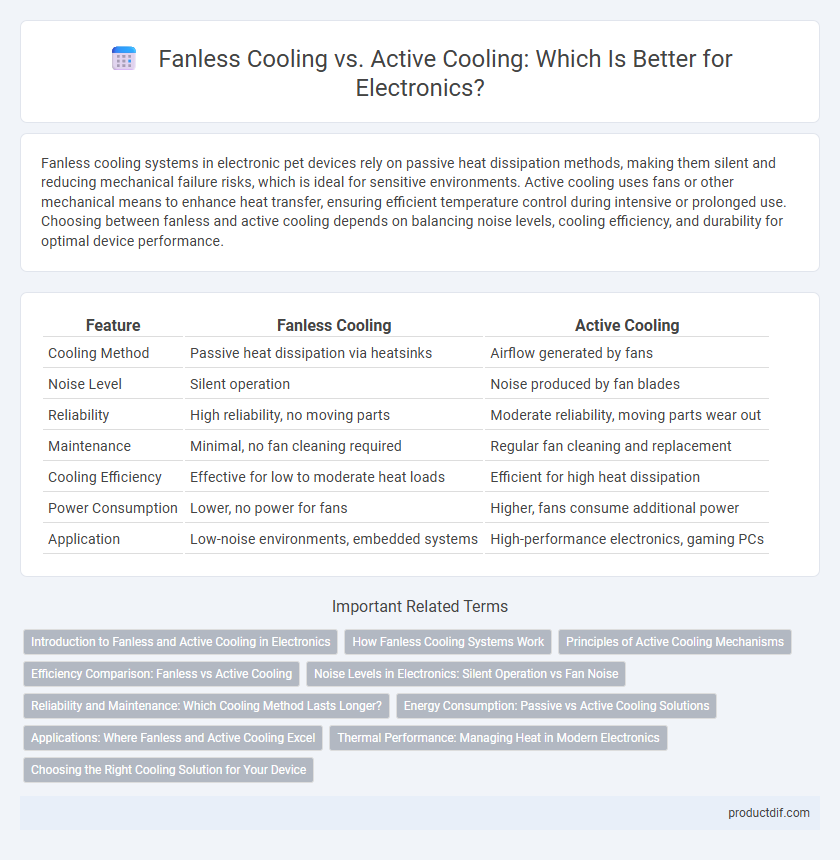Fanless cooling systems in electronic pet devices rely on passive heat dissipation methods, making them silent and reducing mechanical failure risks, which is ideal for sensitive environments. Active cooling uses fans or other mechanical means to enhance heat transfer, ensuring efficient temperature control during intensive or prolonged use. Choosing between fanless and active cooling depends on balancing noise levels, cooling efficiency, and durability for optimal device performance.
Table of Comparison
| Feature | Fanless Cooling | Active Cooling |
|---|---|---|
| Cooling Method | Passive heat dissipation via heatsinks | Airflow generated by fans |
| Noise Level | Silent operation | Noise produced by fan blades |
| Reliability | High reliability, no moving parts | Moderate reliability, moving parts wear out |
| Maintenance | Minimal, no fan cleaning required | Regular fan cleaning and replacement |
| Cooling Efficiency | Effective for low to moderate heat loads | Efficient for high heat dissipation |
| Power Consumption | Lower, no power for fans | Higher, fans consume additional power |
| Application | Low-noise environments, embedded systems | High-performance electronics, gaming PCs |
Introduction to Fanless and Active Cooling in Electronics
Fanless cooling in electronics relies on passive heat dissipation methods such as heat sinks and thermal pads to manage device temperature without noise or moving parts. Active cooling employs fans or liquid cooling systems to enhance heat transfer, ensuring efficient temperature control during high-performance operations. Selection between fanless and active cooling depends on device power consumption, size constraints, and desired noise levels.
How Fanless Cooling Systems Work
Fanless cooling systems dissipate heat through passive methods such as heat sinks and thermal conduction, utilizing materials like aluminum or copper to spread heat away from critical components. These systems rely on natural convection and radiation to transfer heat into the surrounding environment without mechanical moving parts. The absence of fans reduces noise, increases reliability, and lowers maintenance requirements in electronic devices.
Principles of Active Cooling Mechanisms
Active cooling mechanisms in electronics rely on components such as fans, heat sinks, and liquid cooling systems to dissipate heat effectively from devices, enhancing thermal management. Fans increase airflow across heat sinks, accelerating heat transfer away from sensitive components like CPUs and GPUs, preventing overheating and improving performance stability. Liquid cooling employs pumps to circulate coolant through heat exchangers, offering superior heat dissipation for high-performance or densely packed electronic systems.
Efficiency Comparison: Fanless vs Active Cooling
Fanless cooling systems rely on passive heat dissipation through heat sinks and natural convection, providing silent operation and lower power consumption but generally less effective heat management in high-performance electronics. Active cooling utilizes fans or liquid cooling to actively remove heat, significantly improving thermal regulation and efficiency for components with high heat output, albeit with increased energy use and noise. Comparing efficiency, fanless cooling excels in low-to-moderate thermal loads due to zero moving parts and minimal power draw, while active cooling is more efficient for maintaining optimal temperatures in high-power devices, preventing thermal throttling and extending component lifespan.
Noise Levels in Electronics: Silent Operation vs Fan Noise
Fanless cooling systems offer silent operation by eliminating moving parts, making them ideal for noise-sensitive environments such as medical devices and audio equipment. In contrast, active cooling employs fans that generate varying noise levels depending on speed and design, potentially causing audible distractions in quiet settings. Selecting between fanless and active cooling hinges on balancing thermal management efficiency with the acceptable noise threshold for the electronic application.
Reliability and Maintenance: Which Cooling Method Lasts Longer?
Fanless cooling systems offer higher reliability due to the absence of moving parts, reducing the risk of mechanical failure and minimizing maintenance requirements over time. Active cooling relies on fans that can accumulate dust and degrade, necessitating regular cleaning or replacement to maintain optimal performance. Therefore, fanless cooling typically lasts longer and ensures more consistent operation in electronics demanding durability.
Energy Consumption: Passive vs Active Cooling Solutions
Fanless cooling systems utilize passive cooling techniques that rely on natural convection and heat dissipation without power consumption, significantly reducing energy usage compared to active cooling solutions. Active cooling methods employ fans or liquid coolers that consume electrical energy to actively dissipate heat, resulting in higher operational energy costs. Selecting fanless designs enhances energy efficiency in electronics by minimizing power draw and reducing overall thermal management expenses.
Applications: Where Fanless and Active Cooling Excel
Fanless cooling excels in applications requiring silent operation and dust resistance, such as medical devices, telecommunications equipment, and industrial control systems where reliability is critical. Active cooling is preferred in high-performance electronics like gaming PCs, servers, and graphic processing units (GPUs) that generate substantial heat and demand efficient thermal management. Both cooling methods are selected based on device power consumption, environmental conditions, and maintenance constraints.
Thermal Performance: Managing Heat in Modern Electronics
Fanless cooling in electronics relies on passive heat dissipation methods such as heat sinks and thermal conduction, providing silent operation but limited thermal performance under high-power loads. Active cooling employs components like fans or liquid cooling systems to actively transfer heat away from sensitive components, achieving superior heat management and maintaining optimal operating temperatures. Effective thermal performance in modern electronics hinges on balancing the noise and energy consumption of active cooling with the reliability and maintenance-free advantages of fanless designs.
Choosing the Right Cooling Solution for Your Device
Fanless cooling relies on passive heat dissipation using heat sinks and thermal conductive materials, making it ideal for silent, low-power electronics and compact designs. Active cooling employs fans or liquid cooling systems to efficiently manage higher thermal loads in powerful processors and gaming devices, ensuring optimal performance. Selecting the right cooling solution depends on device power consumption, noise tolerance, and space constraints to balance thermal management and operational reliability.
Fanless Cooling vs Active Cooling Infographic

 productdif.com
productdif.com